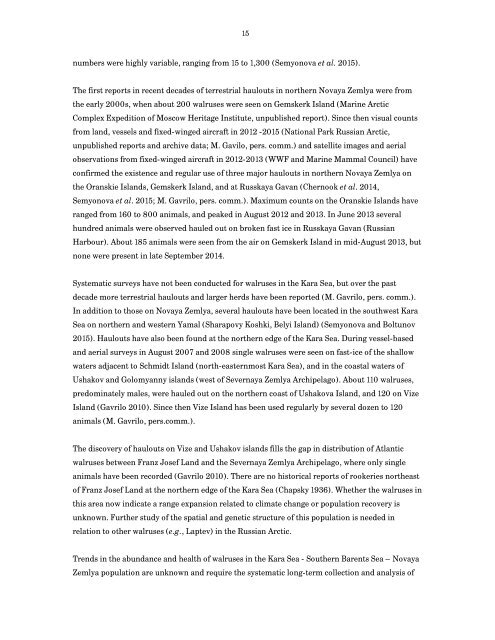The State of Circumpolar Walrus Populations
walrusreport
walrusreport
Create successful ePaper yourself
Turn your PDF publications into a flip-book with our unique Google optimized e-Paper software.
15<br />
numbers were highly variable, ranging from 15 to 1,300 (Semyonova et al. 2015).<br />
<strong>The</strong> first reports in recent decades <strong>of</strong> terrestrial haulouts in northern Novaya Zemlya were from<br />
the early 2000s, when about 200 walruses were seen on Gemskerk Island (Marine Arctic<br />
Complex Expedition <strong>of</strong> Moscow Heritage Institute, unpublished report). Since then visual counts<br />
from land, vessels and fixed-winged aircraft in 2012 -2015 (National Park Russian Arctic,<br />
unpublished reports and archive data; M. Gavilo, pers. comm.) and satellite images and aerial<br />
observations from fixed-winged aircraft in 2012-2013 (WWF and Marine Mammal Council) have<br />
confirmed the existence and regular use <strong>of</strong> three major haulouts in northern Novaya Zemlya on<br />
the Oranskie Islands, Gemskerk Island, and at Russkaya Gavan (Chernook et al. 2014,<br />
Semyonova et al. 2015; M. Gavrilo, pers. comm.). Maximum counts on the Oranskie Islands have<br />
ranged from 160 to 800 animals, and peaked in August 2012 and 2013. In June 2013 several<br />
hundred animals were observed hauled out on broken fast ice in Russkaya Gavan (Russian<br />
Harbour). About 185 animals were seen from the air on Gemskerk Island in mid-August 2013, but<br />
none were present in late September 2014.<br />
Systematic surveys have not been conducted for walruses in the Kara Sea, but over the past<br />
decade more terrestrial haulouts and larger herds have been reported (M. Gavrilo, pers. comm.).<br />
In addition to those on Novaya Zemlya, several haulouts have been located in the southwest Kara<br />
Sea on northern and western Yamal (Sharapovy Koshki, Belyi Island) (Semyonova and Boltunov<br />
2015). Haulouts have also been found at the northern edge <strong>of</strong> the Kara Sea. During vessel-based<br />
and aerial surveys in August 2007 and 2008 single walruses were seen on fast-ice <strong>of</strong> the shallow<br />
waters adjacent to Schmidt Island (north-easternmost Kara Sea), and in the coastal waters <strong>of</strong><br />
Ushakov and Golomyanny islands (west <strong>of</strong> Severnaya Zemlya Archipelago). About 110 walruses,<br />
predominately males, were hauled out on the northern coast <strong>of</strong> Ushakova Island, and 120 on Vize<br />
Island (Gavrilo 2010). Since then Vize Island has been used regularly by several dozen to 120<br />
animals (M. Gavrilo, pers.comm.).<br />
<strong>The</strong> discovery <strong>of</strong> haulouts on Vize and Ushakov islands fills the gap in distribution <strong>of</strong> Atlantic<br />
walruses between Franz Josef Land and the Severnaya Zemlya Archipelago, where only single<br />
animals have been recorded (Gavrilo 2010). <strong>The</strong>re are no historical reports <strong>of</strong> rookeries northeast<br />
<strong>of</strong> Franz Josef Land at the northern edge <strong>of</strong> the Kara Sea (Chapsky 1936). Whether the walruses in<br />
this area now indicate a range expansion related to climate change or population recovery is<br />
unknown. Further study <strong>of</strong> the spatial and genetic structure <strong>of</strong> this population is needed in<br />
relation to other walruses (e.g., Laptev) in the Russian Arctic.<br />
Trends in the abundance and health <strong>of</strong> walruses in the Kara Sea - Southern Barents Sea – Novaya<br />
Zemlya population are unknown and require the systematic long-term collection and analysis <strong>of</strong>


